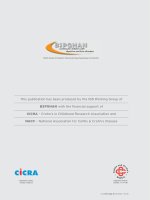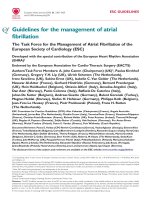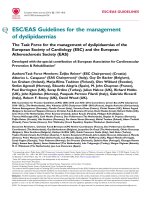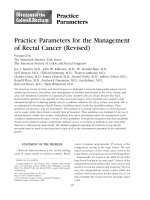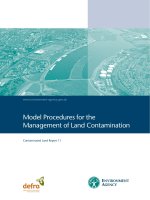Evaluation of newer insecticides for the management of Brinjal shoot and fruit borer leucinodes Orbonalis (Guenee) (Lepidoptera: Crambidae)
Bạn đang xem bản rút gọn của tài liệu. Xem và tải ngay bản đầy đủ của tài liệu tại đây (314.64 KB, 11 trang )
Int.J.Curr.Microbiol.App.Sci (2019) 8(3): 2582-2592
International Journal of Current Microbiology and Applied Sciences
ISSN: 2319-7706 Volume 8 Number 03 (2019)
Journal homepage:
Original Research Article
/>
Evaluation of Newer Insecticides for the Management of Brinjal Shoot and
Fruit Borer Leucinodes orbonalis (Guenee) (Lepidoptera: Crambidae)
M. Shridhara1*, S.G. Hanchinal1, A.G. Sreenivas1, A.C. Hosamani1 and J.M. Nidagundi2
1
Department of Agricultural Entomology, 2Department of Genetics and Plant Breeding, UAS,
Raichur- 584 104, Karnataka, India
*Corresponding author
ABSTRACT
Keywords
Brinjal shoot and
fruit borer,
Leucinodes
orbonalis (Guenee),
brinjal, new
insecticides
Article Info
Accepted:
26 February 2019
Available Online:
10 March 2019
To evaluate the efficacy of new insecticides against brinjal shoot and fruit borer (BSFB),
L. orbonalis, field experiment was carried out in a randomized block design with seven
treatments (six insecticides and one control) and three replications during kharif 2017 at
Main Agricultural Research Station (MARS), Raichur. Among the treatments the lowest
mean per cent shoot damage was recorded in the treatment with emamectin benzoate
5 SG (5.41) followed by chlorantraniliprole 18.5 SC (5.83) and flubendiamide 39.5 SC
(5.93) and were superior than the untreated control (14.66) after first and second spray.
After third spray the lowest mean per cent fruit damage was recorded in the treatment with
chlorantraniliprole 18.5 SC (14.32) followed by flubendiamide 39.5 SC (15.78) and
emamectin benzoate 5 SG (16.30) and were superior than the other treatments. The highest
yield was observed in the treatment with emamectin benzoate 5 SG (25.9 t.ha -1) followed
by flubendiamide 39.5 SC (23.7 t.ha-1) and chlorantraniliprole 18.5 SC (21.8 t.ha-1)
compared to the untreated control (10.4 t.ha -1) and recorded maximum benefit cost ratio in
the field treated with emamectin benzoate 5 SG (1: 3.17) followed by flubendiamide 39.5
SC (1: 2.96) and chlorantraniliprole 18.5 SC (1: 2.63).
Introduction
Brinjal (Solanum melongena L.) is one of the
most widely grown solanaceous vegetable and
is being grown throughout the year under
irrigated condition. A poor man’s crop it
might be, but brinjal is also called as the King
of Vegetables. Due to its nutritive value,
consisting of minerals like iron, phosphorus,
calcium, folate, and vitamins like A, B and C,
unripe fruits are used primarily as vegetable
in the country. It is also used as a raw material
in pickle making and as an excellent remedy
for curing the diabetes. It is also used as a
good apetizer. It is a good aphrodisiac,
cardiotonic, laxative and reliever of
inflammation (Singh et al., 1962). In India
brinjal is grown nearly 7.11 lakh ha with a
production of 13,558 million tonnes and an
average productivity of 19.12 tonnes/ ha
(Anon., 2016), making the country the second
largest producer after China with a 25 per
2582
Int.J.Curr.Microbiol.App.Sci (2019) 8(3): 2582-2592
cent of world production share. In Karnataka,
brinjal is being grown in an area of 1.58 lakh
ha with a production of 402.5 metric tonnes
(3.13 % share) and a productivity of 25.4
metric tonnes per hectare (Anon., 2016).
Though brinjal is a summer crop, it is being
grown throughout the year under irrigated
conditions. Hence, it is subjected to attack by
number of insect pests right from the nursery
stage to till harvesting (Raghupathy et al.,
1997). Brinjal is attacked by more than 70
insect pests, among the insect pest infesting
brinjal, the major ones are shoot and fruit
borer,
Leucinodes
orbonalis
(Guen.),
whitefly, Bemisia tabaci (Genn.), leaf hopper,
Amrasca biguttula biguttula (Ishida),
Epilachna
beetle,
Henosepilachna
vigintioctopunctata (Fab.) and non-insect
pest,
red
spider
mite,
Tetranychus
macfurlanei (Baker and Pritchard). Of these,
the brinjal shoot and fruit borer, L. orbonalis
is considered as the main constraint as it
damages the crop throughout the year. It is
known to damage shoot and fruit of brinjal in
all stages of its growth. The pest is estimated
to cause 70 to 92 per cent yield loss (Vevai et
al., 1970; Subbaratnam and Butani, 1982;
Reddy and Srinivasa, 2004). The brinjal shoot
and fruit borer, L. orbonalis is known to
damage shoots and fruits in all stages of plant
growth. In early stage of the crop growth,
larva bores into the shoots resulting in
drooping, withering and drying of the affected
shoots. During the reproductive stage, tiny
larva bores into the flower buds and fruits, the
bored holes are invariably plugged with
excreta. The infested fruits become unfit for
consumption due to loss of quality and lose
their market value. It is also reported that
there will be reduction in vitamin C content to
an extent of 68 per cent in the infested fruits
(Hemi, 1955). Among the various methods of
pest management, the use of insecticides
forms the first line of defence against the
insect pests. Newer insecticide molecules are
better alternative to conventional synthetic
insecticides in the context of environmentally
benign management tactics so also in order to
mitigate the adverse effect on the total
environment. In many cases, alternate or ecofriendly method of insect management offer
adequate level of pest control with less
hazards and safe to non-target organisms.
With this background, the present study was
undertaken to evaluate the bioefficacy of
newer insecticides against the brinjal shoot
and fruit borer, L. orbonalis.
Materials and Methods
To evaluate the efficacy of new insecticides
against brinjal shoot and fruit borer,
L. orbonalis, field experiment was conducted
during Kharif 2017 at Main Agricultural
Research Station (MARS), Raichur as an
irrigated crop. The experiment was laid out in
a Randomized Block Design (RBD) with
three replications and seven treatments in a 5
x 4 square meter plot with spacing of 90 x 45
cm and the variety used was “Rayadurga”.
The foliar treatments were given using
knapsack compression sprayer. Three foliar
applications were given during the course of
investigation on the basis of the ETL of the
pest. Observations on pest damage were
recorded on ten randomly selected plants
prior to the treatment and after imposing the
treatment. Post treatment observations were
recorded on 1, 3, 7, and 14 days after
spraying. The fruit yield was recorded plot
wise as and when the harvesting was done.
The shoot damage by L. orbonalis was
assessed based on the total number of shoots
and affected shoots in a plot on 10 randomly
selected plants and the per cent shoot damage
was worked out. The fruit damage by L.
orbonalis was assessed based on the total
number of fruits and the number of damaged
fruits in 10 randomly selected plants, and the
per cent fruit damage was worked out. The
yield of brinjal fruits was recorded from each
2583
Int.J.Curr.Microbiol.App.Sci (2019) 8(3): 2582-2592
plot on weight basis and computed to per
hectare. The per cent data recorded for shoot
and fruit damage was converted into
corresponding
angular
transformation
(Arcsine) if the values ranged from 0 to 100
for statistical analysis.
Results and Discussion
At first spray, after fourteen days of imposing
treatments the lowest per cent shoot damage
was recorded in emamectin benzoate 5 SG
(6.60).
This
was
followed
by
chlorantraniliprole
18.5
SC
(6.91),
flubendiamide 39.5 SC (7.12) and all the three
treatments were on par with each other but
significantly superior over rest of the
treatments. The mean lowest per cent shoot
damage was recorded in emamectin benzoate
5 SG (5.41). This was followed by
chlorantraniliprole 18.5 SC (5.83) and
flubendiamide 39.5 SC (5.96) and were
superior than the untreated control (14.66).
The insecticides in the decreasing order of
their efficacy were emamectin benzoate 5 SG
> chlorantraniliprole 18.5 SC > flubendiamide
39.5 SC > cyantraniliprole 10 OD > bifenthrin
10 EC > spinosad 45 SC (Table 1).
At Second spray, Fourteen days after
imposing the treatment, the lowest shoot
damage (8.57 %) was recorded in emamectin
benzoate 5 SG and flubendiamide 39.5 SC
(9.39 %), these treatments were on par with
each other and there was no significant
difference between these treatments. These
were followed by chlorantraniliprole 18.5 SC
(9.71 %) and cyantraniliprole 10 OD (10.57
%). Highest shoot damage of 22.79 per cent
was observed in untreated control. The mean
lowest per cent shoot damage was recorded in
emamectin benzoate 5 SG (6.32). This was
followed by flubendiamide 39.5 SC (6.94)
and chlorantraniliprole 18.5 SC (7.19) and
were superior than the untreated control
(17.88). The insecticides in the decreasing
order of their efficacy were emamectin
benzoate 5 SG > flubendiamide 39.5 SC >
chlorantraniliprole 18.5 SC > cyantraniliprole
10 OD > bifenthrin 10 EC > spinosad 45 SC
(Table 2).
At third spray, Fourteen days after imposing
the treatment, the lowest fruit damage
(16.52%) was recorded in chlorantraniliprole
18.5 SC, which was significantly superior
over rest of the treatments followed
flubendiamide 39.5 SC (17.60 %) and
emamectin benzoate 5 SG (18.14 %), these
treatments were on par with each other and
there was no significant difference between
these treatments. Highest fruit damage of
38.20 per cent was observed in untreated
control. The insecticides in the decreasing
order
of
their
efficacy
were
chlorantraniliprole 18.5 SC > flubendiamide
39.5 SC > emamectin benzoate 5 SG >
cyantraniliprole 10.26 OD > bifenthrin 10 EC
> spinosad 45 SC (Table 3).
Among the different treatments, emamectin
benzoate 5 SG recorded significantly highest
fruit yield (25.90 t/ha) compared to rest of the
treatments. The next best treatments were
flubendiamide 39.5 SC (23.7 t/ha) and
chlorantraniliprole 18.5 SC (21.8 t/ha) which
were on par with each other. The lowest yield
of 10.40 t/ ha was recorded in untreated check
(Table 4).
The cost economics revealed that emamectin
benzoate 5 SG registered higher net profit of
Rs. 141884 ha-1 with B: C ratio (3.17). This
was followed by flubendiamide 39.5 SC,
chlorantraniliprole 18.5 SC, cyantraniliprole
10.26 OD, bifenthrin 10 EC and spinosad 45
SC registered net profit of Rs. 125604,
108179.84, 92325.67, 79256 and 71937.58
ha-1 with B: C ratio of 2.96, 2.63, 2.48, 2.28
and 2.12, respectively and the lowest net
profit of Rs. 15084 with B: C ratio (1.25) was
recorded in untreated control (Table 5).
2584
Int.J.Curr.Microbiol.App.Sci (2019) 8(3): 2582-2592
Table.1 Efficacy of new insecticides against brinjal shoot and fruit borer, L. orbonalis during Kharif 2017
Sl.
No.
Treatments
g a.i /
ha
% Shoot damage
First spray
1 DBS
1
Emamectin benzoate 5 SG
200
2
Flubendiamide 39.5 SC
75
3
Chlorantraniliprole 18.5 SC
62.5
4
Cyantraniliprole 10 OD
500
5
Spinosad 45 SC
62.5
6
Bifenthrin 10 EC
500
7
Untreated control
--
S.Em (±)
--
CD @ 5 %
--
DBS – Day before spraying;
Mean
3 DAS
7.79
6.33
(16.21) (14.57)a
7.70
6.77
(16.11) (15.08)ab
8.46
7.00
(16.91) (15.34)abc
9.27
8.21
(17.73) (16.65)bcd
9.32
9.80
(17.78) (18.24)de
8.20
8.44
(16.64) (16.89)cde
9.47
12.04
(17.47) (20.30)f
NS
7 DAS
3.31
(10.48)a
3.99
(11.52)ab
3.59
(10.92)ab
5.56
(13.64)c
6.70
(15.00)cd
6.34
(14.58)cd
15.54
(23.22)e
Per cent reduction over
control
14 DAS
6.60
5.41
(14.89)a
7.12
5.96
ab
(15.48)
6.91
5.83
ab
(15.24)
8.37
7.38
c
(16.82)
9.50
8.67
cd
(17.95)
8.8
7.86
cd
(17.26)
16.4
14.66
e
(23.89)
63.10
59.35
60.23
49.66
40.86
46.38
--
0.56
0.53
0.42
0.50
--
1.73
1.62
1.28
1.54
--
DAS – Days after spraying;
Figures in parentheses are arc sine transformed values
2585
NS – Non significant
Int.J.Curr.Microbiol.App.Sci (2019) 8(3): 2582-2592
Table.2 Efficacy of new insecticides against brinjal shoot and fruit borer, L. orbonalis during Kharif 2017
Sl.
No.
Treatments
g a.i / ha
% Shoot damage
Mean
Per cent
reduction
over
control
6.32
64.65
6.94
61.19
7.19
59.79
9.07
49.27
9.72
45.64
9.21
48.49
17.88
--
Second spray
1
Emamectin benzoate 5 SG
200
2
Flubendiamide 39.5 SC
75
3
Chlorantraniliprole 18.5 SC
62.5
4
Cyantraniliprole 10 OD
500
5
Spinosad 45 SC
62.5
6
Bifenthrin 10 EC
500
7
Untreated control
--
S. Em (±)
--
CD @ 5 %
--
DBS – Day before spraying;
1 DBS
3 DAS
7 DAS
14 DAS
7.72
(16.13)
7.60
(16.00)
8.37
(16.82)
9.12
(17.58)
9.22
(17.68)
8.12
(16.56)
9.36
(17.82)
7.07
(15.42)ab
7.16
(15.22)a
7.26
(15.63)abc
8.99
(17.45)de
9.14
(17.60)de
8.08
(16.51)abcd
13.52
(21.57)f
3.33
(10.51)a
4.28
(11.93)b
4.59
(12.38)b
7.65
(16.06)c
7.99
(16.42)cd
7.79
(16.21)cd
17.33
(24.60)e
8.57
(17.03)a
9.39
(17.85)ab
9.71
(18.16)bc
10.57
(18.97)c
12.03
(20.29)d
11.76
(20.06)d
22.79
(28.51)e
NS
0.44
0.30
0.32
0.35
--
1.37
0.93
0.99
1.09
--
DAS – Days after spraying;
Figures in parentheses are arc sine transformed values
2586
NS – Non significant
Int.J.Curr.Microbiol.App.Sci (2019) 8(3): 2582-2592
Table.3 Efficacy of new insecticides against brinjal shoot and fruit borer, L. orbonalis during Kharif 2017
Sl. No.
Treatments
g a.i / ha
% fruit damage
Third spray
3 DAS
7 DAS
1 DBS
1
Emamectin benzoate 5 SG
200
2
Flubendiamide 39.5 SC
75
3
Chlorantraniliprole 18.5 SC
62.5
4
Cyantraniliprole 10 OD
500
5
Spinosad 45 SC
62.5
6
Bifenthrin 10 EC
500
7
Untreated control
--
S. Em (±)
--
CD @ 5 %
--
DBS – Day before spraying;
23.00
(28.66)
25.20
(30.13)
24.62
(29.75)
24.02
(29.35)
26.14
(30.75)
26.05
(30.69)
25.22
(30.15)
NS
16.05
(23.62)b
15.36
(23.08)ab
14.28
(22.20)a
23.99
(29.33)c
25.96
(30.63)e
25.78
(30.51)d
33.18
(35.17)f
0.30
14.72
(22.56)b
14.37
(22.28)b
12.16
(20.41)a
24.49
(29.66)c
25.88
(30.58)d
24.40
(29.60)c
35.31
(36.46)e
0.23
18.14
(25.21)b
17.60
(24.80)b
16.52
(23.98)a
28.60
(32.33)d
30.03
(33.23)e
27.50
(31.63)c
38.20
(38.17)f
0.21
16.30
Per cent
reduction
over
control
54.16
15.78
55.62
14.32
59.73
25.69
27.76
27.29
23.26
25.89
27.19
35.56
--
0.25
--
0.92
0.70
0.66
0.76
--
DAS – Days after spraying;
Figures in parentheses are arc sine transformed values
2587
NS – Non significant
Mean
14 DAS
Int.J.Curr.Microbiol.App.Sci (2019) 8(3): 2582-2592
Table.4 Efficacy of new insecticides against brinjal shoot and fruit borer, L. orbonalis during Kharif 2017
Treatments
Dose (g a.i / ha)
Fruit yield
(t/ ha)
Per cent increase over
control
Emamectin benzoate 5 SG
200
25.90
59.85
Flubendiamide 39.5 SC
75
23.70
56.12
Chlorantraniliprole 18.5SC
62.5
21.80
52.30
Cyantraniliprole 10 OD
500
19.30
46.11
Spinosad 45 SC
62.5
17.00
38.82
Bifenthrin 10 EC
500
17.60
40.90
Untreated control
--
-10.40
S.Em (±)
--
0.81
--
CD @ 5 %
--
2.49
--
2588
Int.J.Curr.Microbiol.App.Sci (2019) 8(3): 2582-2592
Table.5 Cost economics for the management of brinjal shoot and fruit borer in brinjal during Kharif 2017
Treatments
Emamectin benzoate 5 SG
Dose
g a.i/ ha
Yield
(t/ ha)
Plant
protection
cost (Rs/
ha)
Other
Expenditure
(Rs/ ha)
200
25.90
5200
23.70
Flubendiamide 39.5 SC
Net returns
(Rs/ ha)
B: C
ratio
Total cost
of
Production
(Rs/ ha)
Gross
returns
(Rs/ ha)
60116
65316
207200
141884
3.17
3880
60116
63996
189600
125604
2.96
75
Chlorantraniliprole 18.5 SC
62.5
21.80
6104.16
60116
66220.16
174400
108179.84
2.63
Cyantraniliprole 10 OD
500
19.30
1958.33
60116
62074.33
154400
92325.67
2.48
Spinosad 45 SC
62.5
17.00
3946.42
60116
64062.42
136000
71937.58
2.12
Bifenthrin 10 EC
500
17.60
1428
60116
61544
140800
79256
2.28
60116
60116
83200
23084
1.25
Untreated control
--
10.40
--
Cost of brinjal- 8 Rs/ Kg (8000/ tonnes)
2589
Int.J.Curr.Microbiol.App.Sci (2019) 8(3): 2582-2592
Fig.1 Yield and B: C ratio of insecticides during Kharif 2017
2590
Int.J.Curr.Microbiol.App.Sci (2019) 8(3): 2582-2592
New novel insecticides were evaluated for their
efficacy to manage the BSFB and compared
with recommended insecticides. Control plots
had significantly higher BSFB infestation at
three, seven and fourteen days after spray as
compared to that on insecticide treated plots.
However, among tested insecticides emamectin
benzoate, chlorantraniprole 18.5 SC and
flubendiamide were relatively more effective
compared to remaining treatments first and
second spray.
The new generation chemicals used in this
study belong to different groups of IRAC
(Insecticide resistance action committee) and
offer unique modes of action. The findings of
present
studies
indicated
that
Chlorantraniliprole
18.50
SC
and/or
Flubendiamide 39.35 SC proved better for the
management of BSFB. These findings
corroborate with the results obtained by Mishra
(2008) and Jagginavar et al. (2009) where they
opined that Chlorantraniliprole 18.50 SC and/or
Flubendiamide 39.35 SC were superior in
controlling BSFB.
after spray. Chlorantraniliprole was most
effective insecticide against BSFB at three,
seven and fourteen days after spray followed by
flubendiamide and emamectin benzoate.
The results of the present study support the
findings of several previous studies. Anil and
Sharma (2010), Sharma and Sharma (2010),
Chatterjee and Mondal (2012) and Shah et al.
(2012) who reported that emamectin benzoate
was the most effective insecticide in reducing
BSFB infestation and increasing marketable
fruit yield.
Among the different treatments, emamectin
benzoate 5 SG recorded significantly highest
fruit yield (25.90 t/ha) compared to rest of the
treatments. The next best treatments were
flubendiamide 39.5 % SC (23.7 t/ha) and
chlorantraniliprole 18.5 SC (21.8 t/ha) which
were on par with each other. Whereas, in
treatments cyantraniliprole 10 OD (19.30 t/ha),
bifenthrin 10 % EC (17.6 t/ha) and spinosad 45
SC (17 t/ha) were the next best treatments in
recording fruit yield (Fig. 1).
Present results are also in accordance with the
study conducted by Shah et al. (2012), who
found
that
emamectin
benzoate
and
flubendiamide were promising insecticides to
lower brinjal shoot and fruit borer infestation
and produce high fruit yield (Latif et al. 2009)
also suggested the application of flubendiamide
in combination with mechanical control, potash
and field sanitation, for reducing fruit and shoot
infestation. Our findings also confirm the
results of the studies conducted by Latif et al.
(2010), who found that flubendiamide caused
maximum larval mortality of BSFB in
laboratory trials while field trials reduced
brinjal shoot and fruit infestation by 70- 80 per
cent.
The lowest yield of 10.40 t/ha was recorded in
untreated check. The results of the present study
support the findings of several previous study
Shirale et al. (2012) who reported that the total
fruit yield was significantly higher in the plots
sprayed with Chlorantraniliprole 18.50 SC
(528.52 q/ ha).
After third spray, control plots had significantly
higher infestation as compared to that of
insecticides applied plot. Among the
insecticides treatments Chlorantraniliprole was
the most effective having the least fruit
infestation at three, seven and fourteen days
Over all, it can be concluded that emamectin
benzoate 5 SG, flubendiamide 39.5 SC and
chlorantraniliprole
18.5
SC
recorded
comparatively lower shoot and fruit damage and
higher fruit yield and were found promising
insecticides for the management of BSFB.
The results on the cost economics of various
treatments revealed that emamectin benzoate 5
% SG and flubendiamide 39.5 SC registered a
high B: C ratio of 3.17 and 2.96, respectively
(Fig. 1). The results of present investigation
were almost in line with findings of Biradar et
al. (2001) they noticed that the B: C ratio for
flubendiamide 39.5 SC was 4.44.
2591
Int.J.Curr.Microbiol.App.Sci (2019) 8(3): 2582-2592
References
Anil and Sharma, P. C., 2010, Bioefficacy of
insecticides against Leucinodes orbonalis
(Guenee) on brinjal. J. environ. Biol., 31:
399- 402.
Anonymous, 2016. National Horticultural
Mission- 2016.
Biradar, A. P., Teggelli, R. G., Patil, D. R. and
Balikai, R. A., 2001, Evaluation of
cypermethrin 3 EC + quinalphos 20 EC
against brinjal shoot and fruit borer.
Karnataka J. Agri. Sci., 14: 369- 372.
Chatterjee, M. L. and Mondal, S., 2012,
Sustainable
management
of
key
lepidopteran insect pests of vegetables.
ISHS Acta Horticult.
Hemi, M. A., 1955, Effect of borer attack on
the vitamin C content of brinjal. Pak. J.
Health, 4: 223-224.
Jagginavar, S. B., Sunitha, N. D. and Biradar,
A. P.,
2009, Bioefficacy of
Flubendiamide 48 SC against brinjal fruit
and shoot borer, Leucinodes orbonalis
Guen. Karnataka J. agric. Sci., 22: 712713.
Latif, M. A., Rahman, M. M., Alam, M. Z. and
Hossain, M. M., 2009, Evaluation of
Flubenbendiamide as an IPM component
for the management of brinjal shoot and
fruit borer, Leucinodes orbonalis Guenee.
Mun. Ent. Zool., 4: 257-267.
Latif, M. A., Rahman, M. M., Alam, M. Z. and
Hossain, M. M., 2010, Evaluation of
Flubenbendiamide as an IPM component
for the management of brinjal shoot and
fruit borer, Leucinodes orbonalis Guenee.
Mun. Ent. Zool., 5: 352-368.
Mishra, H. P., 2008, New promising
insecticides for the management of brinjal
shoot and fruit borer, Leucinodes
orbonalis (Guenee). Pest Manage. Hort.
Ecosys., 14: 140- 147.
Raghupathy,
A.,
Palanisamy,
S.,
Chandramohan, N. and Gunathilagaraj,
K., 1997, A guide on crop pests. Sooriya
desk Top Publishers, Coimbatore, pp.
264.
Reddy, E. S. G. and Srinivasa, 2004,
Management of shoot and fruit borer,
Leucinodes orbonalis (Guen.) in brinjal
using botanicals or oils. Pestology, 28:
50- 52.
Shah, K. D., Bharpoda, T. M. and Jhala, R. C.,
2012, Bio-efficacy of newer molecules of
insecticides against brinjal shoot and fruit
borer, Leucinodes orbonalis (Guen). An
inter. e-J., 1(2): 186-200.
Sharma, A. and Sharma, P. C., 2010, Bioefficacy
of
insecticides
against
Leucinodes orbonalis on brinjal. J.
environ. Biol., 31: 399-402.
Singh,Y. P., Gangwar, S. K. and Thakur, N. S.
A., 1962, Persistence of endosulfan in/on
maize at medium high altitude hills of
Meghalaya. Indian J. Plant Prot., 20(2):
195–197.
Subbaratnam, G. V. and Butani, D. K., 1982,
Chemical control of insect pest complex
of brinjal. Entomologica, 7: 97-100.
Vevai, G. H., Khokhar, K. M. and Ashraf, M.,
1970, Management of insect pests of
Brinjal. Pak. J. Agric. Res., 23: 33-39.
Shirale, D., Patil, M., Zehr, U. and Parimi, S.,
2012, Evaluation of newer insecticides for
the management of brinjal fruit and shoot
borer Leucinodes orbonalis (Guenee).
Indian J. of Plant Prot., 40(4): 273-275
How to cite this article:
Shridhara, M., S.G. Hanchinal, A.G. Sreenivas, A.C. Hosamani and Nidagundi, J.M. 2019.
Evaluation of Newer Insecticides for the Management of Brinjal Shoot and Fruit Borer Leucinodes
orbonalis (Guenee) (Lepidoptera: Crambidae). Int.J.Curr.Microbiol.App.Sci. 8(03): 2582-2592.
doi: />
2592
